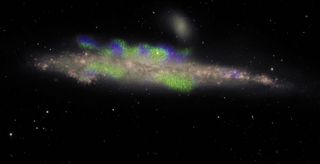Magnetic Ropes Surround 'Whale Galaxy' 80,000 Light-Years Across

If you're feeling all tied up with obligations this holiday season, perhaps a newly studied galaxy feels the same way.
A new image of NGC 4631, more popularly known as the "Whale Galaxy," shows ropes of magnetic filaments extending above and below the disk of the galaxy. The filaments, which show up in green and blue in the picture, reach far into the galaxy's halo of gas and dust. The green filaments have a magnetic field pointing away from Earth; the blue ones have a field pointing toward our planet.
Also visible is the galaxy's star disk, which is shown in pink.
Related: Stunning Photos of Our Milky Way Galaxy (Gallery)
The researchers behind the image are still trying to understand how the galaxy's magnetic structure works, according to a statement released with the image. They would like to know how common these sorts of magnetic fields are in galactic halos and what shapes the fields take.
Studying such magnetic fields can also help astronomers understand how galaxies develop magnetic fields, and whether fluid motion in a galaxy, which scientists call the dynamo effect, generates the magnetic field.
The observations were made with the Karl G. Jansky Very Large Array, a telescope operated by the National Radio Astronomy Observatory (NRAO).
Get the Space.com Newsletter
Breaking space news, the latest updates on rocket launches, skywatching events and more!
"We are a little bit like the blind men and the elephant, since each time we look at the galaxy in a different way, we reach a different conclusion about its nature," co-author Richard Henriksen, an astrophysicist at Queen's University in Canada, said in a NRAO statement.
"However, we seem to have one of those rare occasions where a classical theory, about magnetic generators called dynamos, predicted the observations of NGC 4631 quite well," he added. "Our dynamo model produces spiraling magnetic fields in the halo that are a continuation of the normal spiral arms in the galaxy's disc."
The galaxy lies about 25 million light-years away from Earth in the constellation Canes Venatici. It is 80,000 light-years across and has a small companion (NGC 4627). An additional small elliptical galaxy is visible in the new image.
A research paper based on the work, led by Queen's astrophysicist Judith Irwin, was published in the December 2019 issue of Astronomy & Astrophysics. The theoretical models were described in a May 2019 article in the Monthly Notices of the Royal Astronomical Society, led by Queen's graduate researcher Alex Woodfinden.
Correction: A previous headline for this article stated the Whale Galaxy was 80,000 light-years from Earth. It is 80,000 light-years across and 25 million light-years from Earth.
- Andromeda Galaxy Photos: Amazing Pictures of M31
- Gallery: 65 All-Time Great Galaxy Hits
- The Best Hubble Space Telescope Images of All Time!
Follow Elizabeth Howell on Twitter @howellspace. Follow us on Twitter @Spacedotcom and on Facebook.

Join our Space Forums to keep talking space on the latest missions, night sky and more! And if you have a news tip, correction or comment, let us know at: community@space.com.

Elizabeth Howell (she/her), Ph.D., is a staff writer in the spaceflight channel since 2022 covering diversity, education and gaming as well. She was contributing writer for Space.com for 10 years before joining full-time. Elizabeth's reporting includes multiple exclusives with the White House and Office of the Vice-President of the United States, an exclusive conversation with aspiring space tourist (and NSYNC bassist) Lance Bass, speaking several times with the International Space Station, witnessing five human spaceflight launches on two continents, flying parabolic, working inside a spacesuit, and participating in a simulated Mars mission. Her latest book, "Why Am I Taller?", is co-written with astronaut Dave Williams. Elizabeth holds a Ph.D. and M.Sc. in Space Studies from the University of North Dakota, a Bachelor of Journalism from Canada's Carleton University and a Bachelor of History from Canada's Athabasca University. Elizabeth is also a post-secondary instructor in communications and science at several institutions since 2015; her experience includes developing and teaching an astronomy course at Canada's Algonquin College (with Indigenous content as well) to more than 1,000 students since 2020. Elizabeth first got interested in space after watching the movie Apollo 13 in 1996, and still wants to be an astronaut someday. Mastodon: https://qoto.org/@howellspace
-
Theronuld Somebody was up late last night. 80,000 light years away? Far closer than Andromeda and near our Magellanic clouds. Size is 80K ly . Distance is 25M ly.Reply -
rod ReplyTheronuld said:Somebody was up late last night. 80,000 light years away? Far closer than Andromeda and near our Magellanic clouds. Size is 80K ly . Distance is 25M ly.
Good catch on the title wrong :) The report said "The galaxy lies about 25 million light-years away from Earth in the constellation Canes Venatici. It is 80,000 light-years across and has a small companion (NGC 4627). An additional small elliptical galaxy is visible in the new image." -
Jan Steinman Reply
Yea, I couldn't believe that, either! I was thinking the thing was embedded in our own galaxy, which is about 200,000 light years across.Theronuld said:Somebody was up late last night. 80,000 light years away? Far closer than Andromeda and near our Magellanic clouds. Size is 80K ly . Distance is 25M ly.
